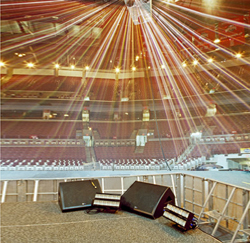For a long time I wondered about mixing monitor wedges in stereo. I was sure it would sound good, so a while back I took the plunge and set up a pair of loudspeakers to see what it was all about.
For about a week I tried different things to see what I could find out. During afternoons on show days, I listened to various instruments and vocal mics.
In many ways the sound was better than listening in mono, particularly when a stereo reverb was applied to a vocal mic, or listening to the grand piano. (We have a 7-foot Steinway with three Barcus Berry Planar Wave pickups to choose from.)
I continued to monitor during shows, using my cue wedges in stereo and setting up a mix with EQ for myself, with real musicians playing real instruments during the performance. It was really no surprise that this set up was more pleasing to the ears, but was it actually a better stage-monitoring configuration?
All Things Being Equal
What I learned initially was that the equalizers being used must be set precisely in order to keep things where you place them in the stereo mix. I suggest using a stereo unit that tracks both channels with one adjustment.
The wedges (including their crossovers and power amplifiers) must be well matched too so that you have very consistent performance from both the left and right loudspeakers. This is essential for controlling the stereo field you are trying to create.
Differences in the frequency response between channels in this type of configuration will cause things to shift location in different ways within the field. For example, if you assigned the hi-hat to stereo wedges with the pan slightly to the left, the wedge on the left was deficient in reproducing the main frequencies in comparison to the right wedge.
In other words, the apparent location of this source when you listened would not be where the pan pot indicated! This in itself may not seem too high a hurdle, but consider an instrument that reproduces a wide range of frequencies like an acoustic guitar.
While it might sound “spacious” being played as a rhythm instrument by itself, you probably don’t want the guitar to pan from one side to the other as the guitarist plays a lead break that goes up and/or down a scale of notes. (Or maybe you do? To each his own…)
The addition of more instruments and more deviations at other frequencies soon presents the listener with an auditory mess. Remember, we’re trying to accurately monitor audio on a stage in a live acoustic environment.















